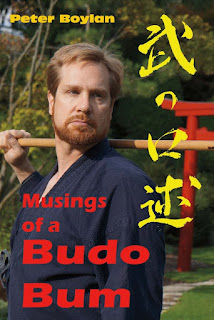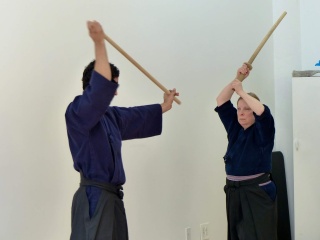 |
| Great day of training. It must have been 95F (35C) in the dojo, though. |
I
talk a lot about the benefits of budo. We go to the dojo and we
sweat. We work at improving some aspect of our skills every
time we enter the dojo. It doesn’t matter how long we’ve been
training or how old we are. My iaido teacher, Kiyama Hiroshi,
was still training in his 90’s. A friend of mine pushed himself to
improve his jodo to challenge for 8th dan when he was 90.He didn’t
make it to 8th dan, but he was pushing himself to improve until the
day he died.
Budo,
much like other Japanese arts such as chano yu
and
shodo,
makes three assumptions about practice and us. First, that perfect
technique can be imagined. Second, that we can always work to come
closer to perfection. Third, that we’ll never achieve perfection,
but that’s no excuse for not continuing to grow and improve.
All
of the streams of thought that come together to form budo assume that
human technique and character can, and should, continue to develop
throughout one’s life. Confucius, Lao Zi, Zhuang Zi, Siddhartha
Gautama (Buddha), all provided strands of thought and ideas to the
cultural stew of China and Japan. All of them assumed that people
could change, grow and improve at every stage of life.
The
Zhuangzi is filled with stories that emphasize taking your time and
learning things. The idea that learning and development never end is
intrinsic to the all of the lines of thought in ancient China that
used “way” 道
as
a metaphor for their school of thought. There
were a lot of them.
On
the other hand, there is a common idea in Western thinking that we
each have some sort of unchanging, immutable core or essence. I’ve
heard many people say “I can’t change. That’s just the way I
am.” or “I don’t like it, but that’s who I am.” Once
they finish high school or college, many people seem to think that
they are done growing, changing and evolving as a person. Thankfully,
there is no evidence to support any of this.
 |
| A curated selection of the best of the the Budo Bum |
Everyone
changes, every day. Whatever we experience changes us. Little things
change us in little ways, and big things can be, as the saying goes,
“life changing.” Life never stops working on us, changing us,
molding us. We are not stone. We are soft flesh that changes and
adapts to the stresses it experiences. An essential question is
whether we are going to be active participants choosing how we change
and what we become, or are we going to be passive recipients of
whatever life does to us..
A
central concept of the idea of a Way, michi
or
do
道
is
that there is always another step to take, another bit of ourselves
we can polish, a bit of our personality that we can improve, and that
we can direct that change. This is true whether we are talking about
Daoist thought or Confucian thought or something in between. The idea
of a finished, unchanging human really doesn’t come up.
Budo
constantly reminds us that we aren’t finished growing, developing,
improving. Rather than declaring that we can’t change, budo is a
claxon calling out that we change whether we want to or not, and that
we can direct that change if we choose. Budo is about choosing
to direct how we change instead of just letting the circumstances of
life change us.
We
are making the choice to take part in how life shapes us from the
moment we enter the dojo, although I doubt many realize how much budo
can influence who we become when we make the decision to start
training. Good budo training should, and does, change us. Physically
we get stronger, more flexible, improve our stamina and develop the
ability to endure fierce training and even injuries. That’s the
obvious stuff. More importantly, budo changes who we are. It should
make us mentally tougher and intellectually more flexible. It should
help us to be more open to new experiences and ideas. It should teach
us that we can transform ourselves. It’s a cliche that budo
training makes people more confident, but it’s also true of good
budo training. You go to the dojo and you get used to people
literally attacking you, and as time goes on, you’re not only okay
with that, but you look forward to it. I don’t know anyone who
started budo training because they enjoyed being attacked, but it
doesn’t take very long before that sort of training, whether it is
done through kata
geiko
or
some sort of randori
or
free sparring, becomes something you look forward to with a smile.
Keiko,
the
formal term for budo practice in Japanese, is the highlight of my
week. The time I spend in the dojo practicing and doing budo never
tires my spirit. It exhausts my body, but my spirit always comes away
refreshed, recharged, and ready to deal with all the stresses of life
outside the dojo. Budo practice isn’t something we “play”. In
Japanese you never use the verbs associated with play when talking
about budo, and even judoka avoid words that emphasize the
competitive and focus on terms like tanren
鍛錬,
forging. Budo is about change; conscious, self-directed change.
The
wonderful thing is that once we learn how to change ourselves in the
dojo, we know how to do it outside the dojo as well. The discomfort
we get used to while pushing ourselves in the dojo teaches us how to
deal with discomfort outside the dojo. That’s one thing budo
doesn’t eliminate – the discomfort of changing. Self-directed
change is difficult and pushes us into places and situations that are
anything but comfortable. I can remember being a pugnacious jerk, and
dealing with disagreement and conflict as a win-lose scenario that I
had to win. It took a lot of time in and out of the dojo to learn
that just because there is conflict there doesn’t have to be a
winner and loser. There are lots of other ways to deal with
conflict, and I’m grateful to my budo teachers that I learned
something about conflict as something other than a zero-sum game.
Budo
has a lot to teach us about life, how we can change and adapt to the
world instead of letting the world change us. All the effort that we
put into learning the techniques and skills of budo also teaches us
how to direct an equal amount of effort into changing any aspect of
ourselves that we wish to confront. The budo path has no end
destination. We just keep working at it.
Special thanks to Deborah Klens-Bigman, PhD. for her editorial support and advice.
via Blogger https://ift.tt/nKOq2gk















